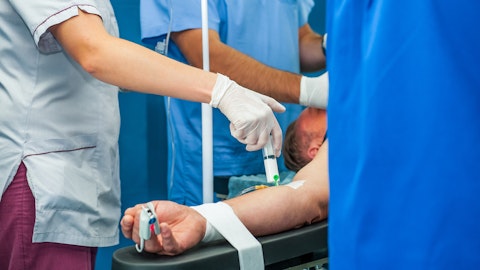SI-BONE, Inc. (NASDAQ:SIBN) Q3 2023 Earnings Call Transcript November 6, 2023
Operator: Good afternoon and welcome to SI-BONE’s Third Quarter Earnings Conference Call. At this time, all participants are in a listen-only mode. We will be facilitating a question and answer session towards the end of today’s call. As a reminder, this call is being recorded for replay purposes. I would now like to turn the call over to Saqib Iqbal, Senior Director of Investor Relations at SI-BONE for a few introductory comments.
Saqib Iqbal: Thank you for participating in today’s call. Joining me are Laura Francis, Chief Executive Officer; and Anshul Maheshwari, Chief Financial Officer. Earlier today, SI-BONE released financial results for the quarter ended September 30, 2023. A copy of the press release is available on the company’s website. Before we begin, I’d like to remind you that management will make statements during this call that include forward-looking statements within the meaning of federal securities laws which are made pursuant to the safe harbor provisions of the Private Securities Litigation Reform Act of 1995. Any statements contained in this call that are related to expectations or predictions of future events, results or performance are forward-looking statements.
These forward-looking statements are based on the Company’s current expectations and inherently involve risks and uncertainties. These risks include SI-BONE’s ability to introduce and commercialize new products and indications, SI-BONE’s ability to maintain favorable reimbursement for its products and procedures, the impact of potential economic weakness on the ability and desire of patients to undergo elective procedures, SI-BONE’s ability to manage risks to its supply chain, the impact of future capital requirements driven by new product introductions, and risks to the continued re-normalization of the healthcare operating environment. Other forward-looking statements include our examination of operating trends, and our future financial expectations, such as expectations for surgeon training and adoption, active surgeons, new products, and clinical trial enrollment, and are based upon our current estimates and various assumptions.
These statements involve material risks and uncertainties that could cause actual results or events to materially differ from those anticipated or implied by these forward-looking statements. During this call, management may discuss certain non-GAAP measures, including the Company’s adjusted EBITDA results. For a reconciliation of these non-GAAP measures to GAAP accounting, please see the Company’s full earnings release issued earlier today. Accordingly, you should not place undue reliance on these statements. For a list and description of the risks and uncertainties associated with our business, please refer to the Risk Factors section of our most recent Form 10-K and Form 10-Q filed with the Securities and Exchange Commission. SI-BONE disclaims any intention or obligation, except as required by law to update or revise any financial projections or forward-looking statements whether because of new information, future events or otherwise.
This conference call contains time-sensitive information and is accurate only as of the live broadcast today, November 6, 2023. With that, I’ll turn the call over to Laura.
Laura Francis: Thanks, Saqib. Good afternoon and thank you for joining us. I’m proud of our performance, as strengthening demand for our solutions allowed us to defy industry seasonality trends and deliver record worldwide revenue for the sixth consecutive quarter. In the third quarter of 2023, we generated worldwide revenue of $34 million, an increase of 29% compared to the third quarter of 2022. The quarterly result was led by record U.S. revenue of $32.3 million which represents U.S. revenue growth of 31% compared to the prior year period. This robust revenue growth also translated into continued improvement in adjusted EBITDA loss and cash outflow and moved us closer to our profitability and cash flow breakeven goals. We also achieved a major surgeon milestone in the third quarter with the number of active surgeons in the quarter exceeding 1,000 for the first time in the Company’s history, performing nearly 3,900 procedures.
Our confidence in the business is reflected in the updated 2023 revenue growth guidance of 28% to 29%. As we look toward 2024, with a market opportunity of nearly $0.5 million annual procedures, we’re in a distinguished position to capitalize on what we believe to be prolonged demand for our expanding portfolio and deliver strong and consistent revenue growth. Before I discuss the progress across our key initiatives, I want to thank our employees for their focus and persistence to create this unique platform and for positioning us to deliver breakout growth. Your impeccable execution ensures we achieve our mission of helping thousands of patients rise up and reach for the stars. Now, let me provide an update on our key initiatives as we look to extend our leadership position and drive strong long-term growth.
Starting with sales infrastructure,. Our direct sales team is our biggest asset as we expand our product portfolio and surgeon base. Our revenue growth and operating leverage over the last several quarters are the outcome of the investments in our seasoned world-class commercial organization. At the end of the third quarter, our U.S. commercial organization was comprised of 83 quota-bearing territory manager. We complement our territory managers with clinical support specialists as well as a growing network of third-party sales agents for case coverage. We also selectively place instrument sets at high-volume hospitals to meet demand. This hybrid strategy allowed us to deliver nearly 30% average growth in both U.S. procedure volume, as well as U.S. active surgeon base over the last four quarters.
This growth has translated into trailing 12-month average revenue per U.S. territory of over $1.5 million, representing a 38% productivity gain over the comparable trailing 12-month period. Moving on to surgeon engagement. We exited the third quarter with over 1,040 active U.S. surgeons, representing approximately 30% growth over the third quarter of 2022. This was the 11th consecutive quarter of double-digit year-over-year growth in our U.S. active surgeons. To put it in perspective, we had approximately a 1,000 surgeons perform a procedure in all of 2021 and now we have a larger number of surgeons perform procedures in a quarter. We’re proud of this milestone, which is the outcome of years of focus on driving surgeon awareness through education, building the best clinical evidence, and expanding our portfolio of solutions to address our surgeons unmet needs.
This elevated level of surgeon interest and engagement is a great forward-looking indicator and underscores the long-term growth trajectory of our business. In the third quarter, nearly half of the active surgeons added in the quarter performed at least one minimally invasive SI joint fusion procedure and then several instances they also performed a pelvic fixation or fragility fracture procedure. We expect our complementary portfolio to drive deeper engagement and increase procedures per surgeon over time. Turning to products and solutions, the U.S. procedure volume trends confirm that with iFuse 3D, iFuse-TORQ and now iFuse Bedrock Granite, the value of our innovative, versatile, and complementary product portfolio has positioned us as the top choice for surgeons looking for sacropelvic solutions.
IFuse-TORQ remains a key growth driver for us due to its expanded clearance covering SI joint dysfunction, trauma and adult deformity. iFuse-TORQ provides complementary technology to iFuse 3D for existing surgeons. It has also been a key driver of new surgeon engagement, as well as successful conversion of surgeons using competitive products when performing minimally invasive SI joint fusion procedures. In trauma, we are engaged with major trauma center thought leaders and are encouraged by the adoption we’re seeing for iFuse-TORQ and sacral insufficiency fractures. At a recent Orthopedic Trauma Association’s event in October, there was tremendous excitement around our solution to address insufficiency fractures. This is consistent with the increase in our trauma procedure volumes in the third quarter of 2023.
Based on an annual incidence of over 120,000 insufficiency fractures in the U.S., the trauma opportunity is of strategic importance to us as the sacropelvic solutions leader and is an important avenue for growth over the long term. What’s equally exciting is the growing interest of trauma surgeons in the diagnosis and treatment of SI joint dysfunction and degeneration. In the third quarter, over one-third of the procedures performed by trauma surgeons were SI joint fusion procedures. Moving to iFuse Bedrock Granite. We’re delighted with the outstanding performance of Granite as we increase our surgical capacity in the quarter to address surgeon demand. The additional capacity positions us well for the current quarter, historically, our seasonally strongest of the year.

The market reception in the pace of adoption underscores Granite’s success and reaffirms our belief that it is becoming the standard of care for a long construct procedures to the pelvis. Following the recent successful launch of our Granite-Closed Head Implant, we’re also poised to introduce another Granite line extension next year. We expect the line extension to accelerate our penetration of shorter multi-level fusion procedures for the treatment of degenerative spine disorders, which already accounts for over 40% of Granite cases today. With over 130,000 annual target procedures, we believe the Granite family of implants will be a crucial growth driver for us over the next several years. Along with the growing demand for Granite, we’re also seeing a consistent trend in surgeons using some combination of our products with Granite to achieve two points of fixation across the SI joint on either side and long construct procedures.
This is driving a significant pull through opportunity for the portfolio and a higher per procedure average selling price. Before I hand the call over to Anshul, I’d like to provide some background on drivers of sacroiliac joint pain incidents in the U.S. and the question of the impact of GLP-1. The primary cause of SI joint dysfunction and degeneration is the altered function of the little ligaments and muscles supporting the SI joint. Changes in the position of the pelvis will also lead to changes in load transfer across the joints. These factors are consistent with the patient demographics in our studies, where over two-third of patients for women of which nearly 80% previously had at least one child. Additionally, the average BMI of the over 300 patients in our INSITE and SIFI studies was between 29 and 30, which closely approximates the average BMI of adult Americans.
Based on data from our clinical studies, it appears that sacroiliac joint pain is more strongly correlated with female gender and traumatic events including pregnancy rather than BMI. Within the deformity market, patients can be classified as those with adult idiopathic scoliosis or adult onset scoliosis. Adult idiopathic scoliosis patients have had scoliosis since childhood and it mainly results from abnormal systemic skeletal growth and asynchronous spinal neuro-boney growth generally due to genetic, hereditary or biomechanical factors. Adult onset scoliosis which typically starts at the age of 50 but presents itself in an average age of 70 is driven by age related asymmetric spinal degeneration and can produce global sagittal misalignment with central and foraminal stenosis.
Based on the data in our SILVIA study, the average patient BMI was between 29 and 30. There is no clear clinical evidence around cause-effective high BMI and scoliosis, making it difficult to determine the direction of causality. This high BMI cause spinal degeneration or does the painful spinal condition tend to correlate with a sedentary lifestyle an elevated BMI? Against this data backdrop, it is in our opinion, not likely that widespread adoption of GLP-1 therapy and a resulting decrease in average BMI in the American population would have a significant impact on the incidents of SI joint dysfunction, trauma or deformity that would meaningfully impact demand for our products in the near or immediate term. 2018 study in the Spine Journal by [indiscernible] of 244 adult spinal deformity patients indicated that BMI greater than 35 was associated with significantly worse peri-operative outcomes and higher cost compared to non-obese patients.
As such, surgeons tend not to want to operate on morbidly obese patients. And the consistent feedback from spine surgeons indicates that if GLP-1 therapy for weight management becomes more widely available, new surgery ready patients may come into our patient funnel as they lose weight. Additionally, as people increase their levels of physical activity and live longer, they will become eligible candidates for musculoskeletal procedures. There’s still a lot that is not known about the impact of GLP-1 drugs, but our data shows that the primary causes of our target disease state are generally related to genetic factors, gender, traumatic events, history of pregnancy and age-related changes. While it would be premature to predict the long term implications of GLP-1, if any, on our musculoskeletal degeneration, in the intermediate term, there is the potential for lower population average BMI to increase the number of surgery eligible patients.
With that, I’ll hand the call over to Anshul.
Anshul Maheshwari: Thanks, Laura. Good afternoon, everyone. I will focus my comments today on third quarter revenue trends, operating leverage and liquidity, and end with our updated 2023 guidance. Additionally, all the comparisons highlighted in my section will be versus the same period in the prior year, unless stated otherwise. Starting with our third quarter revenue. As Laura noted, we delivered another record quarter with worldwide revenue of over $34 million, representing growth of approximately 29%. Third quarter U.S. revenue was $32.3 million, increasing approximately 31%. Our U.S. revenue was driven by growth in procedure volumes, which rose by approximately 34%. The fourth consecutive quarter of over 30% growth in the U.S. case volume highlights the underlying patient demand for our procedures.
The ASP in the quarter reflects the evolving procedure mix as the expanded use of Granite in degenerative procedures to the pelvis resulted in an increase in to-implant Granite cases in the quarter. International revenue was $1.7 million implying nearly flat revenue. We saw strong performance in France and are encouraged by the improvement in the U.K. We are focusing our commercial efforts on revitalizing growth in Germany and the rest of Europe through expanded surgeon engagement. Additionally, given the reception for TORQ in the U.S., we are diligently working on getting notified body clearance to launch TORQ in EMEA. Moving to gross margin and operating leverage. Our gross margin in the quarter was 79%, in line with our expectations. Consistent with recent quarters, the gross margin reflects the impact of procedure and product mix, higher total cost of TORQ and Granite, increase in depreciation from the deployment of instrument trades to support the growing demand for them, depreciation associated with our second facility in Santa Clara and higher freight cost.
Operating expenses were $38.1 million in the quarter, representing 6% growth. The increase in operating expenses was driven by higher commissions associated with the revenue growth, as well as increase in R&D and other commercial activities. We are proud of our demonstrated track record of investing in infrastructure to drive robust revenue growth and then translating that to healthy operating leverage over the last several quarters. Going forward, we remain focused on investing in R&D and clinical research, which are crucial to delivering strong and sustainable revenue growth while progressing towards breakeven. Our net loss was $10 million for the quarter or $0.25 per diluted share. Compared to a net loss of $14.2 million or $0.41 per diluted share in the prior year.
Representing a 29% reduction in net loss. As a reminder, the earnings per diluted share for the third quarter of 2023 were impacted by the increased number of shares outstanding from the May follow on stock offering. Adjusted EBITDA loss in the quarter improved 44% to $3.9 million versus $6.9 million in the prior year period. Adjusted EBITDA loss also improved sequentially by approximately 18%. Turning to liquidity. We exited the third quarter with a solid balance sheet including approximately $167 million in cash and marketable securities. Our cash usage in the quarter was $2.7 million. On a year-to-date basis, cash used in operating activities was $16.4 million, an improvement of 53% compared to $34.9 million in the first three quarters of the prior year.
We are pleased with our trajectory of cash utilization in the last several quarters while making investment in long-term growth initiatives including building incremental surgical capacity to support the anticipated demand for our new products. Finally, moving to our updated guidance for the year. Based on the strong performance throughout 2023, as well as the momentum exiting the third quarter, we are increasing our full year 2023 worldwide revenue guidance. Our revised 2023 annual worldwide revenue guidance is a $136 million to $137 million up from a previous guidance of $132 million to $134 million. This revised guidance translates to year-over-year growth of approximately 28% to 29% versus the previous range of 24% to 26%. We expect the 2023 annual gross margin to be approximately 80% implying fourth quarter gross margin to be in the 78% area due to the factors discussed earlier.
With that, I will turn the call over to the operator for questions.
See also 12 Best High Beta Stocks to Buy Now and 15 Best Cheap Wireless Earbuds Under $50.
Q&A Session
Follow Si-Bone Inc. (NASDAQ:SIBN)
Follow Si-Bone Inc. (NASDAQ:SIBN)
Operator: [Operator Instructions] Our first question comes from the line of Young Li of Jefferies.
Young Li: Hi, guys. Thanks for taking our questions. And congrats on a good quarter and six quarters of record revenue. I guess to start, I appreciate the color on a potential GLP impact. It’s a hot topic. I guess the comments from spine surgeons that lower BMI patients can fall back into the funnel. I guess I’m just wondering, have they or can you quantify that impact? I mean some of the ortho companies have talked about a 10% increase in near-term volumes as a reference point.
Laura Francis: Young, thanks for the question. On GLP-1, I think just talking about the overall addressable market is probably the right place to start. So our – we’re targeting an under-penetrated annual market opportunity of nearly $0.5 million procedures. And so we have a pretty significant runway and we’re confident in our ability to deliver strong and sustainable growth. I did talk a fair amount in my prepared remarks about the causes of the disease state and the general demographic makeup of our typical patients. As we highlighted in that discussion the primary causes for the disease state and I’m talking about SI joint dysfunction specifically as genetic factors, gender, traumatic events, history of pregnancy, as well as age-related changes and we even didn’t provide some information [technical difficulty] SIFI and INSITE studies and actually we did include some info on our SAFFRON study which is trauma as well.
And those patients had average BMI between 29 and 30, which is, which is average BMI for an American. So, based on the data that we shared from these various studies, what we’re trying to do as opposed to some other companies, we’re not speculating on what the issues actually are here. Instead what we’re saying is that we don’t believe that a decrease in average BMI is going to have a significant impact on the incidence of SI joint dysfunction and as well as trauma or deformity, that would be meaningful to the company. And then, if you’re asking, kind of, the question on the flip side of will it actually generate more demand, I did mention that surgeons tend to not want to operate on morbidly obese patients and that’s consistent with the feedback that we’ve received from our spine surgeons indicating that GLP-1 therapy for weight loss management could become more widely available and have more surgery ready patients that are coming into the funnel.
But instead of giving you a number of what that percentage could be, what we’re saying is that we don’t think that there is a significant downside risk and that there is an upside opportunity that’s here as people increase their levels of physical activity, they live longer and that will become eligible candidates for procedures like ours.
Young Li: All right, great. That’s very helpful. I guess the follow-up. I guess, Laura, for your comments in the press release on exiting the year with strong momentum, demand inflection at the early phases. I mean, on the call, you talked about momentum exiting the third quarter. I guess, I’m kind of wondering what are you seeing in 4Q so far, if you can comment on it. Your guidance for the year implies high ’20s growth for the year. Does – your comments sort of imply 20-plus percent growth for next year as well. What can you comment about puts and takes for 2024?
Laura Francis: So, thanks again for the question, Young. What I’ll do is I’ll talk a little bit more about our Q3 performance and I’ll have Anshul talk a little bit more about the future. So I am thrilled with our Q3 performance. It just shows our execution delivering another record quarter and outperformance and it’s really energizing for our team to deliver these strong results despite typical seasonality that you see in the summer time. So just to restate, we delivered 34% growth in U.S. volume, it was the fourth consecutive quarter of 30% plus U.S. volume growth. We saw strong growth across all of our different procedures and we certainly are benefiting from the rollout of the additional Granite and TORQ surgical capacity, which does set us up very well for our seasonally strongest fourth quarter as well as 2024.
Really excited about hitting that major milestone of over a 1,000 active surgeons in the quarter, it was only – in 2021, that we had a 1,000 surgeons do a procedure for the entire year. And then finally, if you look at our adjusted EBITDA loss improvement, in the fact that we only used less than $3 million in cash in the quarter. It really just shows you that we’re in a really strong position here proceeding forward. And it really is about the execution that we’ve been able to show here in 2023. And I mentioned it in your last question, but with around $0.5 million procedures still untapped, it puts us into a great position going forward. So let me have Anshul talk a little bit more about the fourth quarter and 2024.
Anshul Maheshwari: Yes. Hi, Young, good to connect. With regards to our Q4 guide, as we’ve demonstrated throughout this year, we’ve consistently outperformed versus our own guidance just because of our execution and the strong demand that we’re seeing. And some of that is reflected in our, in our updated guide, which was higher than what we beat the market expectations by. So we feel really good about that. We’re very focused on ending the year stronger, given the demand trends, given the record number of active surgeons and the significantly higher surgical capacity coming into the fourth quarter than we were going into the third quarter. So we’re really set up well there. Now in terms of 2024, we’ll provide guidance when we announce our fourth quarter earnings.
We’re just focused on executing for the fourth quarter and to get strong, but like Laura talked about, when you think about the drivers of the robust growth in 2023, all numbers are long term and are very specific to SI-BONE, so our TAM expansion initiatives through the product portfolio, that’s in early stage of their life cycle. We’ve increased our surgical capacity and plan to add more, that’s going to allow us to capitalize on the demand for Granite and TORQ. The surgeon interest remains at a record level and very elevated. So we feel really good about that. And then the last and the most important, the caliber of our sales force and the hybrid model is playing out the way we expected it to be to drive deeper surgeon engagement. So we’re positioned really well, and when you combine these levers with the procedures that are in our TAM, as well as the Granite line extension rollout that we have planned for 2024 and other products in the future, we feel pretty well set from going into 2024 perspective, but even beyond that.
Feel very good about the setup there.
Young Li: All right. Thank you very much for the color.
Operator: Thank you. Please standby for our next question. Our next question comes from the line of Drew Ranieri of Morgan Stanley.
Drew Ranieri: Hi, Laura and Anshul. Thanks for taking the questions. Maybe just to start on utilization for a moment. It looks like utilization kind of held fairly consistent quarter-over-quarter despite kind of the average surgeons going up so significantly. So one, can you just maybe talk to us about what you’re seeing in terms of utilization, kind of on the same surgeon level and what kind of adoption drivers are there seeing there and then layering on some of the newer products?
Laura Francis: Sure, happy to do that. So I’m going to go back to the point about active surgeons in the quarter, we were above 1,000 for the first time in our history. And so that 30% growth, that’s a strong forward-looking indicator and it’s our 11th consecutive quarter of double-digit growth. And I think five-plus quarters of 30% plus growth in that number. So I think what you’re talking about is surgeons per procedure. And so I think from that perspective, talking a little bit about our core business, primary SI joint fusion. If you think about the surgeons that we’re adding, we’re seeing around half of those surgeons that are primary SI joint procedures, whereas the other half approximately is doing some of our pelvic fixation procedures or pelvic ring fracture procedures.




